Summary Overview
Flexible Packaging Market Overview
The global flexible packaging market is expanding promptly, driven by increased demand in industries such as food and beverage, pharmaceuticals, personal care, and consumer products. This market covers a variety of flexible packaging options, such as pouches, wraps, bags, and films, which serve to a wide range of consumer and commercial uses. Our study presents a detailed examination of procurement trends, emphasizing cost-cutting techniques and the use of novel packaging technologies for boosting operational efficiency.
Key future problems in the flexible packaging sector include controlling expenses, sustainability, supply chain resilience, and integrating imaginative packaging technologies into existing production methods. Digital tools and sustainable sourcing techniques are essential for streamlining packaging operations and maintaining long-term competitiveness. The global demand continues to increase, businesses are leveraging market intelligence to enhance production capabilities, reduce environmental impact, and mitigate risks.
-
Market Size: The global Flexible Packaging market is projected to reach USD 402.75 billion by 2035, growing at a CAGR of approximately 5.95% from 2025 to 2035
Growth Rate: 5.95% 
-
Sector Contributions: Growth in the market is driven by:-
Manufacturing and Supply Chain Optimization: The demand for real-time data and seamless integration across processes is increasing as businesses attempt to streamline operations and enhance efficiency in the flexible packaging sector. -
Retail and E-commerce Growth: As the retail and e-commerce sectors grow, there is a greater need for packaging solutions that enable effective inventory management, demand forecasting, and customer relationship management (CRM), resulting in growth in the flexible packaging market.
-
-
Technological Transformation: Advancements in innovations such as machine learning and artificial intelligence are altering the packaging sector by providing better solutions for predictive analytics, automation, and process optimization. -
Innovations: The development of modular packaging solutions enables firms to create packaging systems by selecting only the functionalities required. This strategy reduces expenses while simplifying operational complexity.
-
Investment Initiatives: Companies are transitioning to environmentally conscious and cost-effective packaging solutions, with growing investment in cloud-based technologies that cut infrastructure costs and improve remote accessibility. -
Regional Insights: Asia Pacific and North America continue to dominate the market, owing to strong digital infrastructures and a growing embrace of innovative, sustainable packaging technologies.
Key Trends and Sustainability Outlook:
-
Cloud Integration: Cloud-based packaging solutions are becoming more prevalent for enhanced scalability, cost efficiency, and data management and access across worldwide operations. -
Advanced features: The amalgamation of AI, IoT, and blockchain technology is improving decision-making processes, automating packaging activities, and increasing transparency in the flexible packaging business. -
Focus on Sustainability: Packaging businesses are implementing technologies to optimize resource management and align with sustainability goals, enabling better tracking and reporting to ensure compliance with environmental regulations.
-
Customization Trends: The demand for packaging solutions modified to specific industries, such as pharmaceuticals, food, and consumer goods, is increasing, resulting in more specialized and efficient products. -
Data-Driven Insights: Advanced analytics tools are rapidly being integrated into packaging systems, allowing businesses to estimate demand, manage material usage, and monitor critical performance metrics to make smarter decisions.
Growth Drivers:
-
Digital Transformation: The growing incorporation of digital technologies in manufacturing and packaging processes is driving improved productivity, efficiency, and overall competitiveness. -
Demand for Process Automation: Companies are turning to automated packaging technologies to reduce manual intervention, eliminate bottlenecks, and optimize production procedures, resulting in enhanced overall efficiency. -
Scalability requirements: Flexible packaging organizations want scalable solutions that expand with their growing operations, providing smooth integration and optimization. -
Regulatory compliance: As the packaging sector faces increased regulatory scrutiny, organizations are turning to advanced packaging solutions to maintain compliance, automate reporting, and ensure operational correctness. -
Globalisation: As organizations develop abroad, there is an increased demand for packaging solutions that can handle international regulatory standards, multi-language, and multi-currency operations.
Overview of Market Intelligence Services for the Flexible Packaging Market:
Recent evaluations have highlighted significant challenges in the flexible packaging business, such as high production costs and the necessity for specialized packaging solutions to fulfil various client requests. Market intelligence reports offer important insights into procurement prospects, allowing organizations to establish cost-cutting measures, optimize supplier relationships, and improve packing efficiency. These insights also help to ensure compliance with industry standards, guaranteeing high-quality packaging procedures while successfully managing costs.
Procurement Intelligence for Flexible Packaging: Category Management and Strategic Sourcing
Companies are fine-tuning their approach to purchasing through expenditure evaluation and supplier performance monitoring to remain competitive in the flexible packaging industry. Effective category management and strategic sourcing are critical for lowering procurement costs while ensuring a consistent supply of innovative, high-quality packaging materials. Businesses can improve their procurement strategy by using actionable market intelligence, negotiate better terms with suppliers, and ensure the acquisition of packaging solutions that meet both cost and quality requirements.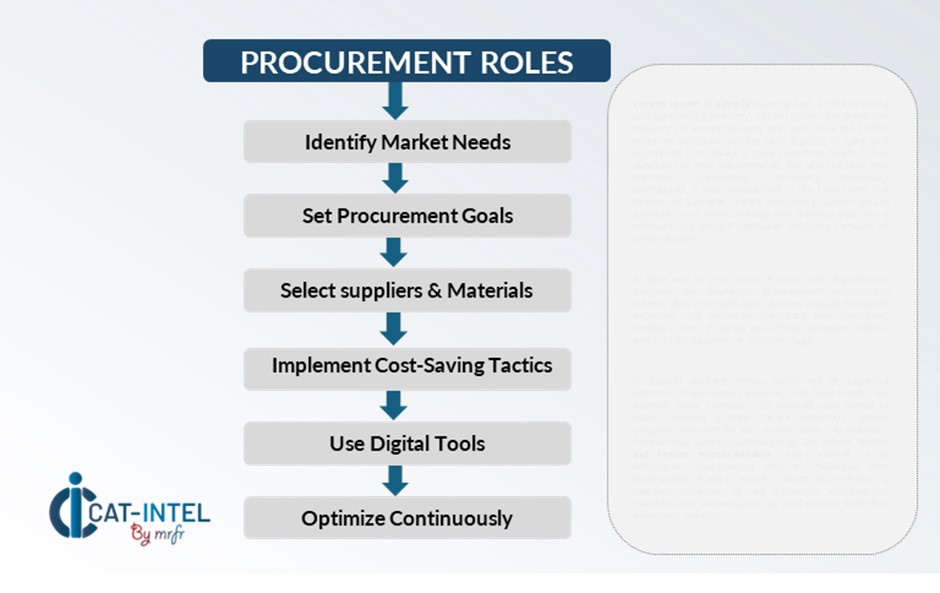
Pricing Outlook for Flexible Packaging: Spend Analysis
The pricing prognosis for flexible packaging solutions is likely to be moderately dynamic, impacted by several factors. Technological improvements, rising demand for sustainable and eco-friendly materials, customized requirements, and regional price variances are all significant drivers. Furthermore, the increased adoption of smart packaging technologies such as IoT and RFID, combined with increasing regulatory requirements for sustainability and waste reduction, is expected to drive up cost trends in the flexible packaging market.
Graph shows general upward trend pricing for Flexible Packaging and growing demand. However, there may be fluctuations influenced by economic conditions, technological advancements, and competitive dynamic.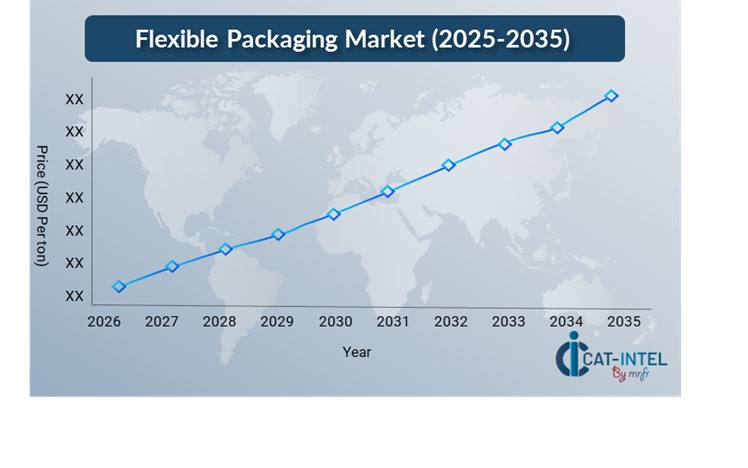 Efforts to optimize procurement procedures, strengthen supplier relationships, and implement more sustainable packaging options are critical for cost control. The use of digital tools for market monitoring, advanced analytics-based pricing predictions, and effective contract administration can drastically reduce costs.
Efforts to optimize procurement procedures, strengthen supplier relationships, and implement more sustainable packaging options are critical for cost control. The use of digital tools for market monitoring, advanced analytics-based pricing predictions, and effective contract administration can drastically reduce costs.
Collaborating with trustworthy packaging suppliers, establishing long-term contracts, and researching volume-based pricing structures are useful techniques. Despite these hurdles, focusing on scalability, guaranteeing smooth production and deployment, and using cloud-based platforms will be critical to preserving efficiency and excellence in operation.
Cost Breakdown for Flexible Packaging: Total Cost of Ownership (TCO) and Cost-Saving Opportunities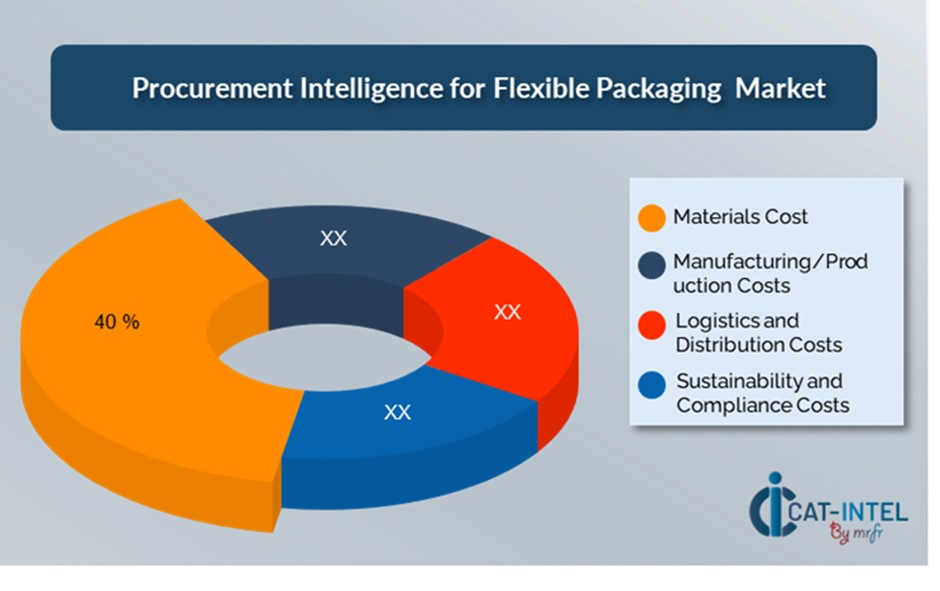
- Material Costs: (40%)
-
Description: Raw materials used in flexible packaging, such as plastics, films, and laminates. These costs account for most of the total cost because the quality, type, and source of materials have a direct impact on package performance, durability, and sustainability. -
Trends: Bioplastics and biodegradable films are examples of materials that are becoming increasingly sustainable and recyclable. Consumer desire for eco-friendly packaging, as well as governmental pressure, are driving this development, despite these materials frequently cost more than traditional materials.
- Manufacturing/Production Costs: (XX%)
- Logistics and Distribution Costs: (XX%)
- Sustainability and Compliance Costs: (XX%)
Cost-Saving Opportunities: Negotiation Levers and Purchasing Negotiation Strategies
In the flexible packaging business, refining procurement tactics and implementing strategic negotiation approaches can result in significant reductions in expenses and increased operational efficiency. Long-term collaborations with package suppliers, particularly those that use sustainable and innovative materials, can result in more appealing pricing models and terms, such as volume discounts and bundled packaging solutions. Subscription-based agreements or multi-year contracts provide additional chances to get reduced rates and safeguard against fluctuations in prices over time.
Partnering with suppliers who focus on innovation and scalability can bring additional benefits, including access to cutting-edge technology such as smart packaging, RFID integration, and modular packaging solutions, which might drive down long-term production costs.
Supply and Demand Overview for Flexible Packaging: Demand-Supply Dynamics and Buyer Intelligence for Effective Supplier Relationship Management (SRM)
The flexible packaging market is growing steadily, driven by rising demand for sustainable, efficient, and customized packaging solutions in industries such as food and beverage, healthcare, and consumer products. Packaging technological breakthroughs, sustainability trends, and global economic situations all have an impact on market supply and demand dynamics.
Demand factors:
-
Sustainability and Environmentally Conscious Initiatives: The growing need for ecologically sound packaging is driving consumer interest in renewable and recyclable packaging products in a variety of industries. -
Shift to Smart Packaging: The proliferation of smart packaging solutions, such as RFID and IoT-enabled features, is driving demand for innovative, technology-driven packaging that improves consumer interaction and tracking capabilities. - Industry Specific Requirements: Food and pharmaceutical industries demand packaging solutions that are tailored to meet stringent regulatory requirements, ensuring compliance with safety and quality norms while optimizing operational workflows.
-
Customisation and Flexibility: Businesses are increasingly searching for modular and adaptable packaging solutions that can fulfil the wide range of product needs, from bulk items to premium, high-end packaging.
Supply Factors:
-
Technological Advancements: Improvements in materials science, such as biodegradable plastics and sustainable coatings, are improving packaging offerings, increasing supplier competitiveness, and fulfilling growing demand for environmentally friendly solutions. -
Vendor Ecosystem: An expanded ecosystem of flexible packaging vendors, ranging from large-scale providers to niche innovators, ensures that consumers have a wide range of solutions tailored to their specific requirements.
-
Global Economic Factors: Changes in raw material costs, labour availability, and regional legislation all have an impact on package pricing and supply chain dynamics, especially in expanding countries. -
Scalability and Flexibility: Modern flexible packaging solutions are becoming more modular and adaptable, allowing providers to serve organizations of all sizes and complexity, from tiny firms to major multinational corporations.
Regional Demand-Supply Outlook: Flexible Packaging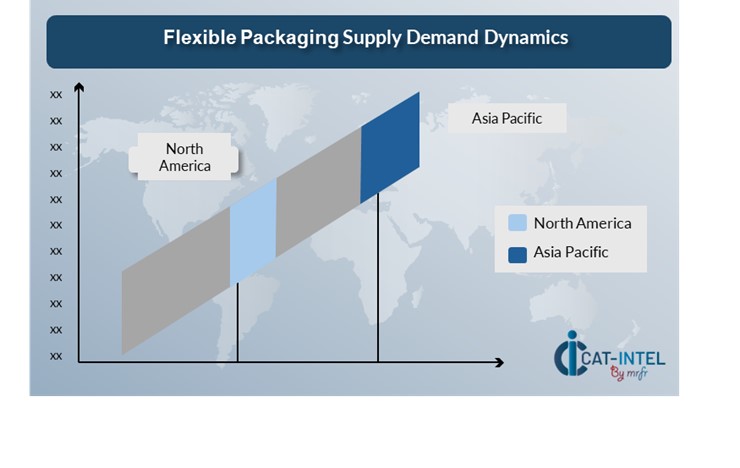
The Image shows growing demand for Flexible Packaging in both Asia Pacific and North America, with potential price increases and increased Competition.
Asia Pacific: Dominance in the Flexible Packaging Market
Asia Pacific, particularly China, is a dominant force in the global Flexible Packaging market due to several key factors:
-
High Demand for Consumer Goods: Asia Pacific is home to some of the world's largest consumer markets, including China and India, which have a burgeoning middle class. The demand for packaged food, beverages, and personal care goods is quickly expanding, necessitating the use of flexible packaging solutions. -
Cost-Effective Manufacturing: The region has relatively low labour and production expenses, making it an appealing location for flexible packaging makers. This cost advantage allows for competitive pricing and greater manufacturing capacity. -
Rapid Urbanization and Changing Lifestyles: Rapid urbanization and moves toward more modern lifestyles in Asia Pacific countries stimulate demand for convenience products with flexible packaging. -
Strong Supplier Network: Asia Pacific has a large network of raw material suppliers, including polyethylene and polypropylene, which are required for flexible packaging. The region's access to those materials, combined with superior technology for production, promotes the expansion of the flexible packaging sector. -
Government Support and Regulations: Many Asia-Pacific governments provide incentives for manufacturing and sustainability efforts. Regulations concentrating on decreasing plastic waste and promoting the use of recyclable materials are also pushing for breakthroughs in eco-friendly flexible packaging solutions.
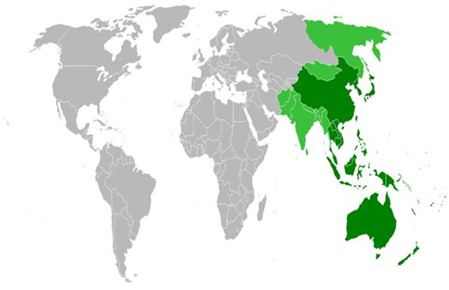
Asia Pacific Remains a key hub Flexing Packaging Price Drivers Innovation and Growth.
Supplier Landscape: Supplier Negotiations and Strategies
The flexible packaging market's supplier landscape is diversified and competitive, with global industry leaders and regional suppliers both impacting market dynamics. These suppliers influence important elements like price models, customization options, material innovation, and service quality. Well-established packaging companies dominate the market, providing complete packaging solutions, while smaller, specialist players specialize in certain areas or offer distinctive characteristics such as sustainable materials or advanced printing methods.
The flexible packaging supplier ecosystem encompasses significant regions, including North America, Europe, and Asia Pacific. Both prominent worldwide vendors and Innovative local players address industry-specific requirements. As businesses across industries prioritize sustainability, operational efficiency, and supply chain resilience, packaging suppliers are developing eco-friendly solutions, incorporating smart packaging technologies such as RFID and IoT, while offering flexible pricing models to meet evolving customer needs.
Key Suppliers in the Flexible Packaging Market Include:
- UFlex Limited
- Amcor Limited
- Sealed Air Corporation
- Berry Global, Inc.
- Mondi Group
- Constantia Flexibles
- Sappi Lanaken
- TC Transcontinental
- Huhtamaki Group
- Sinopack

Key Developments Procurement Category Significant Development:
Significant Development |
Description |
Market Growth |
The flexible packaging industry is expanding swiftly, fuelled by rising demand for sustainable, efficient, and adaptable packaging alternatives, particularly in emerging regions. Flexible packaging is increasingly being used in industries such as food and beverage, healthcare, and consumer products to increase product shelf life, decrease waste, and improve branding.
|
Cloud Adoption |
In response to changing corporate environments and hybrid work approaches, there is a significant shift toward stored in the cloud customized packaging solutions, driven by demand for scalability, cost efficiency, and ease of access. Cloud systems enable packaging companies to handle production, inventory, and shipping remotely, providing in greater operational flexibility.
|
Product Innovation |
Flexible packaging suppliers are increasing their products with innovative solutions, such as smart packaging, which uses IoT, RFID tags, and AI-powered analytics to track and monitor products throughout the supply chain. |
Technological Advancements |
Advanced printing technologies, smart packaging, and automation are all contributing to increased flexibility in packaging. Using machine learning for predictive demand forecasting and robotic process automation (RPA) to improve production processes can help packaging companies increase efficiency and cut costs. |
Global Trade Dynamics |
Changes in trade legislation, tariffs, and compliance requirements are affecting the use of flexible packaging solutions, especially among large businesses operating complicated worldwide supply chains. Adapting to these requirements and ensuring that packaging meets local standards grows more important for businesses operating in an assortment of areas |
Customization Trends |
The need for customized flexible packaging solutions is increasing, as businesses seek more tailored, modular selections that meet unique product requirements. Packaging that reflects brand identities, consumer preferences, and operational workflows is becoming increasingly important, leading to higher demand for tailored and adaptable packaging solutions.
|
|
Flexible Packaging Software Attribute/Metric |
Details |
Market Sizing |
The global Flexible Packaging market is projected to reach USD 402.75 billion by 2035, growing at a CAGR of approximately 5.95% from 2025 to 2035.
|
Flexible Packaging Technology Adoption Rate |
Around 65% of organizations globally have implemented flexible packaging solutions, with a focus on cloud-based systems for scalability and flexibility.
|
Top Flexible Packaging Industry Strategies for 2025 |
Key initiatives include incorporating AI for predictive analytics, establishing modular solutions, addressing cybersecurity, and utilizing mobile technologies to improve accessibility.
|
Flexible Packaging Process Automation |
To improve productivity, over 55% of organizations automate processes such as inventory management and compliance reporting. |
Flexible Packaging Process Challenges |
High implementation costs, reluctance to change, data migration concerns, and continuous system updates and maintenance are all significant challenges.
|
Key Suppliers |
Leading suppliers in the market include UFlex Limited, Amcor Limited and Sealed Air Corporation. |
Key Regions Covered |
Prominent regions for Flexible Packaging are Asia Pacific and North America, owing to strong digital infrastructures and a growing embrace of innovative, sustainable packaging technologies. |
Market Drivers and Trends |
The need for efficient, sustainable packaging drives growth, as does the increased adoption of cloud solutions, immediate data, and advanced technology like as AI and IoT.
|

